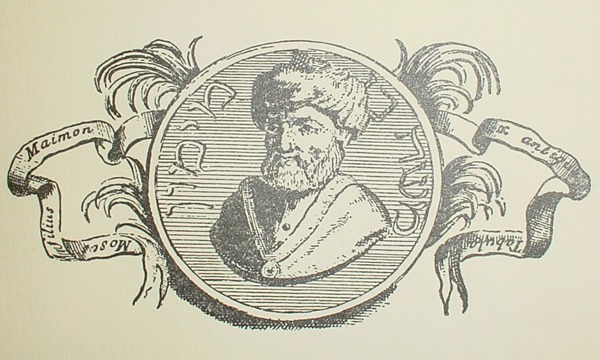
Please chime in by way of a “like” in FB if you encountered the Rambam machberet in Hebrew School, growing up and in what years. If I remember correctly, my Maimonides was heavier set. Extra points for anyone who know the origin of this important artifact. I guess we’d have to start with Hecht’s Hebrew Books & Gifts in Brooklyn, on Coney Island.
As for the image itself, here’s what one learns here on In the Main Line; whether it’s true or not i can’t say:
“Apparently this image was ‘discovered’ in the mid 19th century by Italian scholar Yashar (R. Isacco Samuele Reggio, 1784-1855). Reggio found the following portrait in a 34-volume encylopedic work called ‘ Thesaurus antiquitatum sacrarum’ (1744-69).
Here it is:

Read an excerpt from an interesting letter, dated 1847, by a Jewish Christian missionary living in England named Moses Margoliouth:
“I know you [ie, Rev. Dr. J. Horlock] are a profound admirer of that Hebrew sage. I think you will be pleased, therefore, with the accompanying miniature portrait of him. You may have seen it before, for I printed it as a heading to the prospectus of the Philo-Hebraic Society. If not, here it is. I do not think that anybody in England ever saw it before I introduced it. You will, however, wonder whether it is a real likeness, or merely a fictitious one. I will, therefore, give you all the information I possess about it, and judge for yourself. The famous Italian-Hebrew Scholar, Reggio, discovered it first in that masterpiece of a work, “Thesaurus Antiquitatum,” published at Venice, by Blaseus Ugolinus. He sent a sketch of his discovery to his friend, Herr Solomon Stern, of Berlin. The latter was naturally anxious to know whether the representation was real or imaginary. Reggio, therefore, sent the following explanation; ” In the celebrated work, ‘ Thesaurus Antiquitatum Sacrarum Blasie Ugolini, Venetiis, 1744,’ in the first volume, p. 384, is found the likeness of Maimonides, which the author [of ‘ Thesaurus Antiquitatum’] says was taken, ‘ ex-antiqua tabula,’ without, however, stating more fully and circumstantially how he came to the possession of this tabula, where it existed, and if any one bore testimony to the authenticity of the likeness. However, as Ugolinus is known as an industrious, honourable man, acquainted with his subject, and who cannot easily be suspected of fraud, there is nothing against assuming the probability that at the publication of his work he had really before him such a tabula.”
“Herr Solomon Stern printed on one sheet of paper a few copies of the above miniature, accompanied by a copy of Reggio’s letter. I was fortunate enough to get a copy of that document, sent to me by a kind friend from Berlin, who knows my partiality for such literary curiosities.”
So there you have it. The image is certainly from 1744, but the editor of the Thesaurus antiquitatum sacrarum claimed that it was copied from an old image. Margoliouth must be believed that it was not common in England in 1847, even if it isn’t literally true that it was he who ‘brought’ it to England – not that it needn’t be. By 1906 it must have been widespread, thus it seems to have originated in the mid 18th century, been ‘discovered’ in the mid 19th by Reggio, and disseminated from there.

Approximately 1964 in Philadelphia.
1970s Baltimore
Its familiarity warms the heart ,
Sent from my iPhone
>
In the 50’s in day school